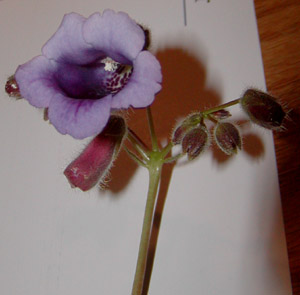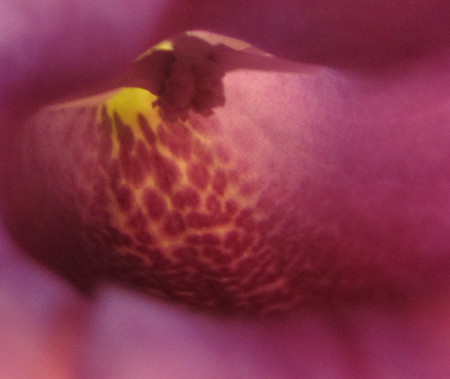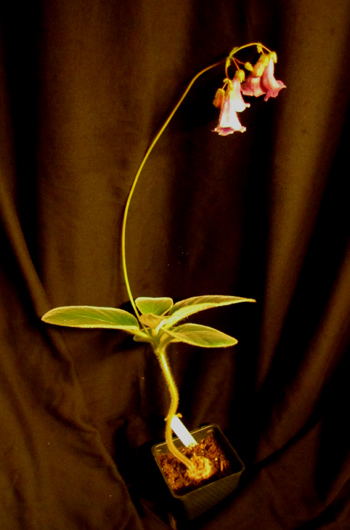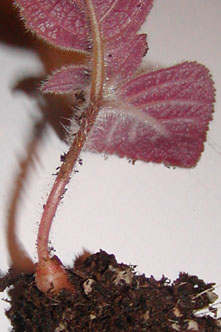Sinningia aghensis
The Flowerstalk Height Champion

Sinningia aghensis has large purple flowers held high above the plant on a very tall flowerstalk.
| Species list |
Hybrids list |
Tubers list |
Topics list |
Site index |
What's new |
Home page |
Sinningia aghensis
|
|

|
Sinningia aghensis has large purple flowers held high above the plant on a very tall flowerstalk. |
|
This species is remarkable for the height of its flowerstalk, a record-holder in the genus. The flowers are bell-shaped and purple, and therefore presumably bee-pollinated, unlike the majority of sinningias, which attract hummingbirds. The picture shows a closeup of the tube, with spotting on the floor of the corolla, and the bunched anthers above. My pictures on this page are of poor quality, with regard to both framing and color accuracy. Unfortunately, I do not have this species any longer, so I can't replace the pictures with better ones. |

|

|
The Whole PlantBecause of the height of the flowerstalk, it is hard to get a good picture of the whole plant when it is in bloom. As is obvious from this picture, I haven't succeeded yet. I'm working on it. CultureI have not been able to get flowers on my plants every year. It seems to be fussier than S. sp. "Ibitioca" about growing conditions. Like the latter, it does appear to need a lot of light. So far, it appears that both S. aghensis and S. bragae (formerly sp. "Ibitioca") do better indoors, at least under my conditions. This differs from 90% of sinningia species and hybrids, which for me flourish outdoors, the main exceptions being some of the miniatures. ColdIn my yard, Sinningia aghensis is less tolerant of cold than most other large sinningia species. No S. aghensis that I left outdoors over the winter has ever come back in the spring, no matter how sheltered the location or mild the winter. My guess is that somewhere around 40 F (4 C) is the minimum for this species. This is another trait it shares with S. bragae. |
SeedlingsSeedlings of this species have dark leaves, almost black, with maroon reverses. As the plants get older, the leaf color turns to dark green, and the leafbacks lose some or all of the reddish color. This species may be closely related to S. bragae, which also has a tall inflorescence and purple bell-shaped flowers, and likewise has seedlings with dark leaves. See a comparison of their flowers and seedlings. It may also be a close relative of S. flammea, judging by the strong resemblance in seedlings and inflorescence. It is not uncommon for sinningia seedlings to have leaves which differ from those of the mature plant. One of the most striking examples is S. leucotricha, which has ordinary green leaves when young. |

|
TuberSinningia aghensis has a typical "bagel" tuber. The shape isn't unusual, but its development is. My seedlings of this species generate tubers very early. The tubers are quite large compared to the size of the seedling. In one case, a spindly seedling which had been overgrown and shaded by other seedlings had a white, etiolated stem and minute leaves about 1 mm long. The tuber, on the other hand, was 5 mm in diameter. This rapid tuber development may be related to the habitat in which it grows. It could be an adaptation to slow plant growth in dry conditions, similar to the way cacti create internal storage before enlarging. |
HybridizationSinningia aghensis has been crossed with S. pusilla. See this hybrid's page for pictures and details. A few other crosses have been done with S. aghensis, referenced on the Corytholoma crossing page. |
| Plant Description |
|
| Growth | Determinate on blooming-age plants |
| Habit | Stems upright on blooming-age plants |
| Leaves | Almost black when young, green later, with more or less red on leafback (see a picture). Two-three leaf pairs per stem. |
| Dormancy | Stems of mature plants are fully deciduous. Seedlings which have not bloomed do not necessarily go dormant. |
Flowering |
|
| Inflorescence | terminal peduncle |
| Season | Flowers in summer |
| Flower | Purple, campanulate |
Horticultural aspects |
|
| From seed | Two years to bloom, under my conditions |
| Hardiness | Not frost-tolerant (see above) |
| Recommended? | Maybe. If it doesn't bloom under your conditions, try something else. Be prepared to give it some vertical space! |
Hybridization |
|
| Hybrids with this species | See listing. |
Botany |
|
| Taxonomic group | The aghensis group of the Corytholoma clade. |
PublicationChautems, 1991. Etymology: agh- (see below) + -ensis ("resident of"). According to Alain Chautems, "the name refers to the first location I was aware of: `Monte Agha' which is a granitic inselberg somewhat shaped like an H which is pronounced "agha" in portuguese!" |